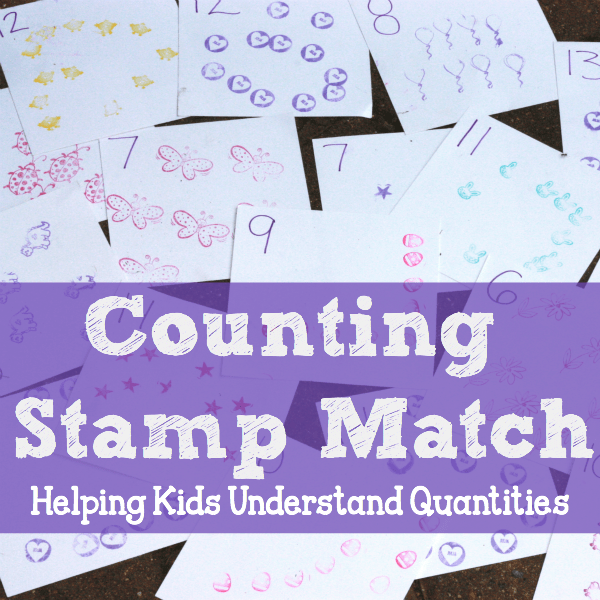Counting Stamp Match

Stamping has been all the rage with my twin girls lately. One day, while covering every square inch of a sheet of paper in random holiday stamps, my 4-year old said, “I think we should write a number and stamp that many on a paper and count them up!” The Counting Stamp Match was born!
Understanding that numbers are not just symbols, but represent quantities, is an important concept for young children. Too often, children can recite their numbers, but don’t fully understand what the numbers represent. I also noticed my girls struggling with the meaning behind words like more, less, most, and least. This combined activity and game can help children with understanding and comparing numbers.
You’ll need:
- 20-25 blank index cards or white cardstock cut into rectangles. (I used 12×12 scrapbooking paper cut into quarters)
- Stamps (Stickers would work great, too!)
- Stamp pads
- Wet paper towel for cleaning stamps
- A marker for writing the numbers
First, decide what would be the right amount of challenge for your child without being too frustrating. I thought doing numbers 1-10 would be too easy, but 10-20 could be pretty challenging, so I did 5-15. Both girls skip number 13 when counting, so I hoped this activity would help.
Second, make two sets of cards by writing one number on each card. So I ended up with 22 cards total. Two sets of cards, each labeled with numbers 5-15.
Next, have your child identify the number on each card and then stamp the same number of stamps (or place stickers) on the card. If you are doing this activity with one child, they could do two cards for each number or you could do it along with them to create the matching set. Having extra cards handy is a good idea since they may get carried away with stamping. Using stickers would make it easier to fix mistakes.
Practice counting by checking for accuracy after stamping
.
Once, the cards are done, it’s fun to flip them all over and mix them up!
Lay the cards out face down and you are ready to play a number version of memory. Take turns turning over two cards at a time looking for a match. After each turn, we briefly talked about why it wasn’t a match using the terms more, less, most, and least. For example: “I got 8 and 13. Thirteen is the most. Eight is less than thirteen so it’s not a match. Your turn!” The kids quickly followed my lead and we would all discuss which number was more and which was less when they chose their cards. Since we had been talking about more or less with every turn, when we finally did get a match, I could introduce the term equal. “Oh, 14 and 14! We can’t say which is the most and which is the least because they are equal! They are same amount.”
They were both excited with each new match, shouting, “Woohoo! We got a match!” Although I hadn’t planned it, we played the game collaboratively and put all of our matches together. We could then organize the pairs from the least to the most. Seeing the kids collaborate instead of compete was much more fun than the “Having fun and playing by the rules is more important than winning.” pep talk I had prepared. Who doesn’t love seeing kids having fun and working together while learning?
Amy is a former reading and third grade teacher as well as a mother to three little girls with big personalities. She believes joy can always be found in playing, learning, and ice cream.










 Amy is a former reading and third grade teacher as well as a mother to three little girls with big personalities. She believes joy can always be found in playing, learning, and ice cream.
Amy is a former reading and third grade teacher as well as a mother to three little girls with big personalities. She believes joy can always be found in playing, learning, and ice cream.



I was looking for your lego farm animal match up and the link led me to the stamp activity. Is there a way you could email me the link please? Thank you!
Hi Nikki,
Unfortunately the LEGO Animal Match Up post has been deleted. I wrote the post when I first started blogging and used pictures of animals that weren’t mine (I didn’t understand the proper etiquette at the time). The post was deleted, but it is very similar to this post. Just use 2 Duplos and your own pictures of farm animals. Hope this helps! :) https://www.icanteachmychild.com/lego-picture-puzzles/
Thanks,
Jenae